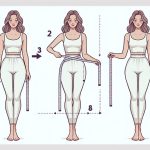I recently stumbled upon a fascinating statistic that highlighted the significance of waist-to-hip ratio in predicting health outcomes. It's intriguing how these two simple measurements can offer valuable insights into our overall well-being and potential risks.
Understanding the implications of waist versus hip measurements goes beyond mere numbers; it can provide a window into our health profile and guide us towards making informed choices.
Exploring the nuances of these measurements could offer a deeper understanding of our bodies and how we can aim for peak health.
Table of Contents
Key Takeaways
- Waist measurement crucial for health risks assessment.
- Hips measurement aids in body shape evaluation.
- Waist-to-hip ratio predicts cardiovascular health.
- Achieving ideal proportions reduces disease risks.
Importance of Accurate Measurements
Stressing the importance of precise measurements is essential for understanding body composition and evaluating associated health risks. The waist-to-hip ratio plays a critical role in predicting the likelihood of heart disease and other chronic conditions based on body fat distribution. By ensuring accurate measurements of the waist and hip, individuals can gather valuable insights into their overall health status. Maintaining a waist measurement below 35 inches for women and 40 inches for men is recommended to reduce the risk of medical complications. Proper techniques, such as using a cloth tape measure and locating specific anatomical points, are essential for obtaining reliable waist and hip measurements.
Understanding the significance of these measurements goes beyond mere numbers; it can guide individuals in making informed decisions regarding their health and well-being. Achieving a healthy waist-to-hip ratio isn't just about aesthetics but is closely linked to reducing the chances of developing heart disease and other health issues. Mastering the art of accurate waist and hip measurements is a fundamental step towards promoting a healthier body and lifestyle.
Waist Measurement Guidelines
When measuring your waist, pinpointing the narrowest area around your midsection is crucial for accurate results.
Wearing snug clothing during the measurement process guarantees consistency and reliability.
Keeping your waist size below 35 inches for women and 40 inches for men can help lower the risk of health issues.
Healthy Waist Size
To maintain excellent health, it is essential to adhere to waist measurement guidelines that recommend keeping the waist size below 35 inches for women and 40 inches for men. Maintaining a healthy waist size is vital in reducing the risk of developing cardiovascular diseases and other health complications associated with abdominal obesity. By monitoring waist circumference and ensuring it stays within the recommended limits, individuals can proactively manage their health and well-being.
| Measurement | Women (inches) | Men (inches) |
|---|---|---|
| Healthy Range | Less than 35 | Less than 40 |
| Risk of Disease | Increased risk | Increased risk |
| Health Awareness | Essential | Essential |
Importance of Ratios
Moving from the discussion on Healthy Waist Size, it becomes evident that understanding the importance of ratios, particularly the waist-to-hip ratio, is fundamental for evaluating health risks connected with body fat distribution.
The waist-to-hip ratio predicts health risks, with values above 1.0 indicating higher risk for conditions like heart disease. Guidelines suggest waist measurements below 35 inches for women and 40 inches for men to reduce health complications.
Accurate waist measurement involves locating the natural waistline and using a cloth tape measure without evaluation. Hip measurements at the widest part aid in evaluating body shape, with guidelines recommending tight clothing for precision.
Calculating the waist-to-hip ratio by dividing waist measurement by hip measurement helps in understanding body fat distribution and health risks.
Hips Measurement Guidelines
For accurate hip measurements, it's important to measure at the widest part of the buttocks using a cloth tape measure. This aids in determining the hip circumference, aiding in evaluating body shape and fat distribution.
To measure the hips correctly, wrap the measuring tape around the fullest part of the hips without compressing the skin. This measurement complements waist measurements and is essential for achieving accurate fitting garments.
When measuring your hips, it's advisable to wear tight clothing to get precise measurements. Proper technique involves keeping the tape measure parallel to the floor and snug against the body.
Waist-to-Hip Ratio Explanation
Understanding the waist-to-hip ratio provides valuable insights into body fat distribution and associated health risks. Calculated by dividing the waist measurement by the hip measurement, this ratio is an important indicator of abdominal fat levels.
Here are key points to keep in mind:
- A higher waist-to-hip ratio, particularly above 1.0, signifies more abdominal fat, which is linked to increased health risks.
- This ratio is a superior predictor of cardiovascular disease and mortality in older individuals compared to simple waist circumference or BMI measurements.
- Genetics, stress hormones, and insulin sensitivities influence the waist-to-hip ratio, contributing to variations in body shape.
- Maintaining a healthy waist-to-hip ratio through lifestyle choices such as diet and exercise can help mitigate the health risks associated with abdominal obesity.
- By understanding and monitoring your waist-to-hip ratio, you can proactively manage your body fat distribution and reduce the likelihood of cardiovascular issues.
Waist Vs Hip: Key Differences
Comparing waist and hip measurements provides important insights into body composition and shape. Waist measurement is taken at the narrowest part of the torso, focusing on evaluating abdominal fat levels. Waist circumference is strongly associated with health risks such as cardiovascular disease, as excess fat around the abdomen can be particularly harmful.
On the other hand, hip measurement is taken at the widest part of the lower body, aiding in understanding body shape and fat distribution. Hip measurement plays a critical role in garment fitting and design.
Calculating the waist-to-hip ratio by dividing the waist measurement by the hip measurement helps predict health risks related to body shape. Understanding the distinctions between waist and hip measurements is vital for not only health evaluation but also for tailoring clothing to fit the body's unique proportions effectively.
Measuring Your Waist Correctly
When measuring your waist correctly, position the tape measure at the narrowest part of your torso, typically above the belly button and below the ribcage. To guarantee an accurate measurement, follow these steps:
- Use the Right Tool: Employ a cloth tape measure for precise readings.
- Snug Fit: Make sure the tape measure is snug against the skin without compressing it.
- Wear Tight Clothing: Opt for tight clothing to prevent inaccuracies caused by loose fabric.
- Natural State: Refrain from sucking in your stomach or holding your breath to obtain a true measurement.
- Consistency is Key: Regular and precise waist measurements are fundamental for monitoring changes in body fat distribution and evaluating associated health risks over time.
Mastering the art of measuring your waist accurately is essential for tracking your body composition and understanding potential health implications. By following these guidelines, you can obtain reliable waist measurements that serve as valuable indicators of your overall health and well-being.
Measuring Your Hips Correctly
When measuring your hips correctly, remember to find the widest part of your buttocks for the most important measurement.
Using a flexible cloth tape measure, wrap it around the fullest part of your hips without applying pressure.
Accurate hip measurements are essential for determining body proportions and ensuring the right fit when choosing or creating clothing.
Proper Hip Measurement Technique
To measure your hips accurately, locate the widest part of your buttocks and hips. When measuring your hips, it's important to use a flexible cloth tape measure and wrap it snugly around the widest part of your hips. Avoid compressing the tape measure too tightly to guarantee a precise hip measurement.
Hip measurements play a vital role in evaluating body shape and fat distribution. Remember to wear tight clothing when measuring your hips and keep the tape parallel to the floor for an accurate measurement.
- Identify the widest part of your hips and buttocks
- Use a flexible cloth tape measure
- Wrap the tape snugly around the widest part of your hips
- Avoid compressing the tape measure too tightly
- Keep the tape parallel to the floor
Importance of Hip Measurements
Understanding the significance of hip measurements is important for accurately evaluating body shape and optimizing garment fit. When measuring your hips correctly, make sure the tape measure wraps around the widest part of your buttocks without compression. This measurement is vital for tailoring well-fitted garments that enhance your silhouette and accommodate your body's unique fat distribution. By mastering hip measurements, you can create clothes that not only fit comfortably but also flatter your body shape. Below is a table summarizing key points related to hip measurements:
| Importance of Hip Measurements | ||
|---|---|---|
| Assess Body Shape | Optimize Garment Fit | Enhance Silhouette |
Calculating Waist-to-Hip Ratio
Calculating my waist-to-hip ratio involves dividing my waist measurement by my hip measurement. This ratio is an important indicator of body fat distribution and the associated health risks, particularly related to abdominal obesity. Here are some key points to take into account:
- Waist-to-hip ratio calculation: Divide the waist measurement by the hip measurement to obtain this ratio.
- Health implications: Higher ratios, especially beyond recommended levels, signify elevated health risks.
- Gender differences: Ideal ratios vary between men and women, with specific values indicating abdominal obesity.
- Risk assessment: Monitoring changes in the waist-to-hip ratio is crucial for understanding overall health and disease prevention.
- Body fat distribution: The ratio provides insights into how fat is distributed in the body, impacting health outcomes.
Understanding and managing your waist-to-hip ratio can play a significant role in maintaining good health and well-being.
Optimal Waist to Hip Proportions
Maintaining ideal waist to hip proportions is key for reducing health risks and promoting overall well-being. The perfect waist-to-hip ratio for women is typically 0.7, indicating a smaller waist compared to the hips. On the other hand, men generally aim for a ratio of around 0.9, signifying a balanced distribution of fat between the waist and hips. These ratios are associated with lower risks of cardiovascular diseases and other health complications. Deviations from these ideal ratios can indicate an increased likelihood of obesity-related issues, emphasizing the importance of monitoring waist-to-hip proportions. Achieving and sustaining ideal waist-to-hip proportions through lifestyle choices like diet and exercise can significantly contribute to overall health and well-being.
| Gender | Optimal Waist-to-Hip Ratio | Health Implications |
|---|---|---|
| Women | 0.7 | Lower risks of cardiovascular diseases |
| Men | 0.9 | Balanced fat distribution |
Maintaining these ratios through lifestyle choices is crucial in preventing health complications.
Choosing Between Hip and Waist Measurements
When deciding between hip and waist measurements for clothing design, the garment's style and fit requirements play an essential role in determining the focus. Understanding the specific garment's design needs is critical for selecting the appropriate measurement emphasis between the hips and waist.
- Clothing Style: Different styles of clothing require either hip or waist measurements to make sure the garment fits and flatters the wearer according to the design intent.
- Garment Design: The design of the garment, such as skirts or dresses, will dictate whether hip or waist measurements are more important for achieving the desired look.
- Fitting: Proper fitting garments rely on accurate measurements, so choosing the right focus between hips and waist is crucial for a comfortable and stylish fit.
- Hips and Buttocks: Hip measurements play a significant role in accommodating the hips and buttocks, especially for bottoms like pants and skirts.
- Hourglass Figure: For individuals with an hourglass figure, balancing hip and waist measurements is key to accentuating their natural curves and achieving a proportionate look.
Achieving Ideal Waist and Hip Measurements
To achieve ideal waist and hip measurements, understanding the body's proportions and natural curves is essential. The waist-to-hip ratio (WHR) plays a significant role in determining the balance and symmetry of one's body shape. A WHR below 0.8 is generally considered pivotal for women, indicating a smaller waist circumference in relation to the hips.
When it comes to garment construction, accurate measurements of the waist and hips are vital for creating clothing that not only fits well but also enhances the wearer's silhouette. By tailoring garments to match the individual's WHR, designers can craft pieces that aren't only visually appealing but also comfortable to wear.
Consideration of waist and hip measurements is key to complementing body shapes and emphasizing natural curves. By incorporating the concept of WHR into the design process, clothing can be tailored to flatter different body proportions, leading to well-fitted and attractive attire.
Frequently Asked Questions
Are Hip and Waist Measurements the Same?
Hip and waist measurements are distinct. The waist focuses on the narrowest torso point, while the hips capture the widest part of the lower body. Understanding this difference is crucial for precise clothing sizing and fit.
How Much Bigger Should Your Hips Be Than Your Waist?
In mastering body proportions, understanding the ideal waist-to-hip ratio is crucial. Achieving a balance where the hips are slightly larger than the waist, typically around 0.7 to 0.8, can create an attractive silhouette that reflects a curvier figure.
How Do I Properly Measure My Waist and Hips?
To measure my waist and hips, I locate my natural waistline between my hipbones and ribs for the waist, and around the widest part of my buttocks for the hips. I use a cloth tape measure without checking and make sure it stays parallel to the floor.
What Is the Attractive Waist-To-Hip Ratio?
The attractive waist-to-hip ratio is typically around 0.7 for women, signifying a smaller waist compared to the hips. This ratio is widely regarded as appealing across various cultures and influences perceptions of beauty.
- The Cowboy’s Secret: Why Silk Charmeuse Is a Top Choice for Wild Rags - June 20, 2025
- What Is Washable Silk Charmeuse and Is It Worth It? - June 20, 2025
- The Best Uses for Charmeuse as a Luxury Lining Fabric - June 20, 2025




